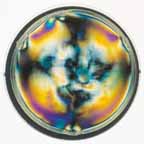
QED IONIZATION SPECTROSCOPY
QED Ionization
Cavity QED Induced EM Radiation enables ionization spectroscopy at VUV levels beyond 7-12 eV. An ultrasonic transducer opens and closes the gap between a pair of flat glass surfaces. Ionization is described in - Theory.
Difficulties in fabricating the dynamic QED module to provide gaps < 100 nm that negated the notion of ionization spectroscopy. Efforts were then directed to a static QED module using etched silicon chips to achieve submicron gaps. But this was negated by dirt particles on the chip surface. - Experiment.
Ambient Light Source
A light source operating from ambient thermal energy is proposed using cavity QED induced EM radiation. The light is produced in a nanoporous solid, each void comprising a QED cavity that converts IR radiation into VIS light.
Flow Electrification
Photochemical reactions induced by cavity QED induced EM radiation are proposed as the source of flow electrification. VUV radiation is produced as van der Waals bonds break as the nanoscale gap opens in the slip-flow at solid boundaries, the VUV producing cations and electrons by the photoelectric effect.
Space charge
Space charge in the polyethylene (PE) insulation of power cables is proposed produced at the instant QED cavities form as van der Waals bonds in the interstice between PE molecules break at low stress levels. By photolysis, the VUV radiation scissions the PE molecule at stress levels far below the levels necessary for tensile fracture consistent with experimental observation.
Hydrodynamic Cavitations
Light emission and flow electrification in hydrodynamic cavitations are shown to follow the frequency up-conversion of suppressed IR radiation inherent in Sonoluminescence.
Liquid Phase Stability
Langevin's notion that the phase stability of88888 liquids originates in the lower osmotic pressure in the liquid relative to that at the surface is supported by the suppression of IR radiation by cavity QED induced EM radiation.
Condensation
Light emission in the condensation of noble gases at low pressure containing clusters of silver atoms is shown to be consistent with cavity QED induced EM radiation.
Quantum Dots
The dramatic increase of electron yield in quantum dots (QD) over that in the bulk is explained by the conversion of non-radiative photon absorption into thermal kT energy and attendant IR radiation that in nanoscale structures is suppressed, the loss of suppressed IR conserved by a gain at the EM resonant frequency of the QD, typically for Planck energy > 20 eV. By photoluminescence, the VUV produces instantaneous excitons consistent with experiment, thereby obviating the need for the current explanation of high QD efficiency based on successive impact ionization with attendant time delays Extensions are made to an alternative to molecular dissociation by multphoton IR radiation.
Bubble Fusion Litigation surrounding the hoax of bubble fusion including: Buvbble fusion at Purdce University, Fraud in the US Patent Office, and Supreme Court representation.